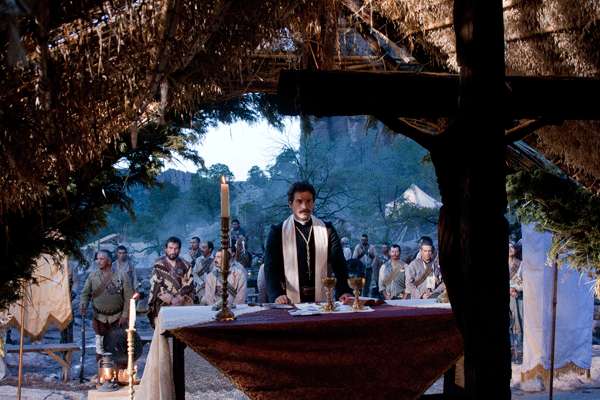
MEXICO CITY (CNS) — Even as modern-day church-state relations improve, the impact of Mexico’s three-year Cristero Rebellion in the 1920s on the Catholic Church remains widely debated in Mexican society.
The rebellion saw Catholic clergy and laity taking up arms to oppose government efforts to harshly restrict the influence of the church and defend religious freedom. In the end, the rebellion of the Cristero — soldiers for Christ — was quelled in 1929, leaving the church sidelined for much of the last century and its role limited to a pastoral concerns with no say in the public policy arena.
Ask Mexicans about the rebellion and the answers about what it means today depends on a person’s point of view.
Catholics leaders consider the government’s actions to limit church influence that led to the rebellion an attack on religious freedom. Self-described liberals and many in the Mexican political and intellectual classes consider the suppression of the revolt a triumph of the secular state. Some academics and authors are less passionate, describing the uprising as an agrarian conflict with political and religious overtones.
Now the conflict comes to the big screen at a time with improved church-state interaction — even if the interpretations of one of Mexico’s defining events remain controversial.
“What price would you pay for freedom?” posed the synopsis for the movie, “For Greater Glory,” which stars Andy Garcia and Eva Longoria and opens in the United States June 1.
The synopsis continued, “An impassioned group of men and women each make the decision to risk it all for family, faith and the very future of their country.”
Gen. Enrique Gorostieta Velarde, the protagonist played by Garcia and leader of the Cristero forces, is a “retired military man who at first thinks he has nothing personal at stake. … Yet the man who hesitates in joining the cause will soon become the resistance’s most inspiring and self-sacrificing leader, as he begins to see the cost of religious persecution on his countrymen.”
Like various histories of the rebellion, Gorostieta’s actions remain open to interpretation. Some question his motives for leading the rebel cause despite being a nonbeliever; others wonder if he really did have a conversion late in life.
Victor Ramos Cortes, a professor at the University of Guadalajara, said any reading of history must consider the factors of religious intolerance, agrarian land issues in a country with numerous landless farmers and the threat posed by the church hierarchy to the liberal elites of the time.
Such nuanced readings of the era are rare.
“In our country, each history is presented as if it were the only true version and the other is erroneous,” Ramos said.
The Cristero legacy remains somewhat divisive, with the conflict and the beatification and canonization of Cristero martyrs at the center of the church’s agenda.
The Archdiocese of Guadalajara is building a large sanctuary on a prominent hilltop to memorialize Mexico’s martyrs, and Pope Benedict XVI celebrated Mass during his visit in March for 640,000 people at the foot of the Cerro del Cubilete, site of a giant Christ statue built to remember those fighting the rebellion.
Father Manuel Corral, Mexican bishops’ conference spokesman, has seen the film and speaks well of its message of “showing young people that there’s something worth fighting for.”
He also considers its release a sign of how much Mexico has changed in terms of religious tolerance and the more prominent role the church is taking in public life.
“Twenty-five years ago, it would have been impossible to release a movie like this,” he said.
How far Mexico has come is evident in the film’s subject matter, too.
“It was a violent era and there were a lot of ambitious generals. Gen. Gorostieta was one of them,” said Richard Grabman, author of “Gorostieta and the Cristiada, Mexico’s Catholic Insurgency 1926-1929.”
“The Cristeros attracted a lot of people that were not necessarily religious, but looking for a military solution to social problems,” he said.
Mexico had emerged from a violent revolution during the 1910s, which was fought mainly to end the enduring rule of then-President Jose de la Cruz Porfirio Diaz and give properties to the landless peasants being exploited by hacienda owners.
The revolutionary elite emerging from the conflict were anti-clerical and had approved a 1917 constitution forbidding the church to own property and operate schools, limiting worship to authorized churches and stripping priests of civil political rights. “Iniquis Afflictisque” (“On the Persecution of the Church in Mexico”), a 1926 encyclical by Pope Pius XI, said the constitution “placed (priests) in the same class with criminals and the insane.”
Grabman said that, especially in rural areas, priests competed for influence with teachers whose orders were to spread a secular ethos. Teachers were viewed by the central government as a counterweight to clergy and as such, he explained, were killed in large numbers by Cristero fighters.
Many of the Cristeros were small landowners, unlike those taking up arms in the revolution.
Haciendas were less common in the main areas of the conflict, which covered an area of west-central Mexican known as the Bajio.
“Cristero were small landowners threatened by social change,” Grabman said. “They feared (agrarian reform) would be collective agriculture.”
The relationship between the Bajio landowners and their workers was different from the exploitation on haciendas suffered by peons taking up arms in the revolution.
“They saw their farm workers as family, instead of peons,” Grabman said.
Gorostieta, the retired general, had experience with attempting to suppress peasant uprisings in Morelos state, fighting the forces of revolutionary leader Emilano Zapata, whose troops were fighting for “land and liberty.” Grabman said it left an impression on Gorostieta when he learned that “farmers without military training could be a formidable force when fighting for a belief.”
The Cristero Rebellion was suppressed in 1929, but many of the small landowners persisted, even if the church hierarchy was moving on.
“We have people who are children of Cristeros,” said Father Jorge Raul Villegas, spokesman for the Archdiocese of Leon, which encompasses Bajio.
“For us, it’s a historic reality since there were men who died defending the faith. This isn’t forgotten.”
— By David Agren, Catholic News Service






